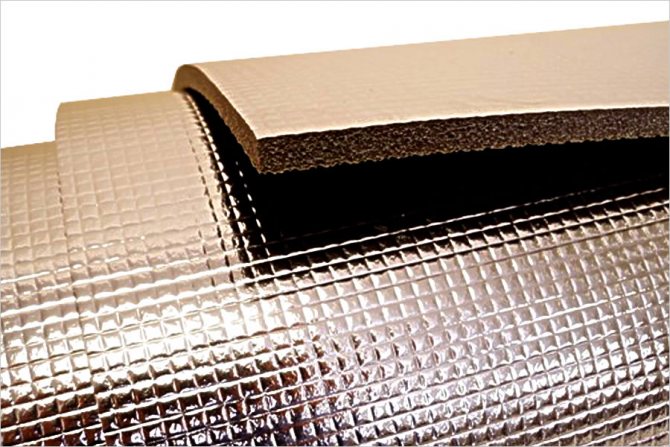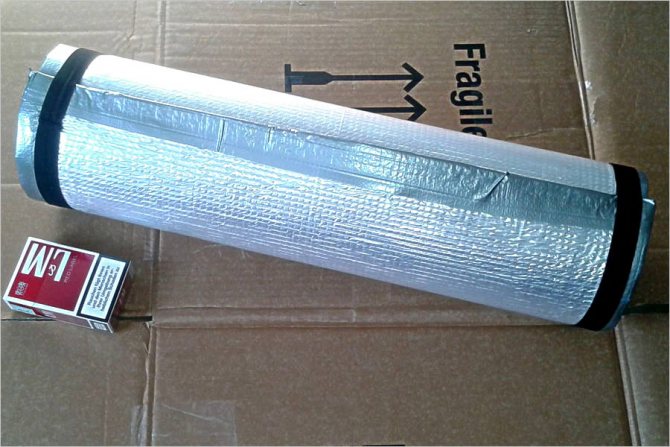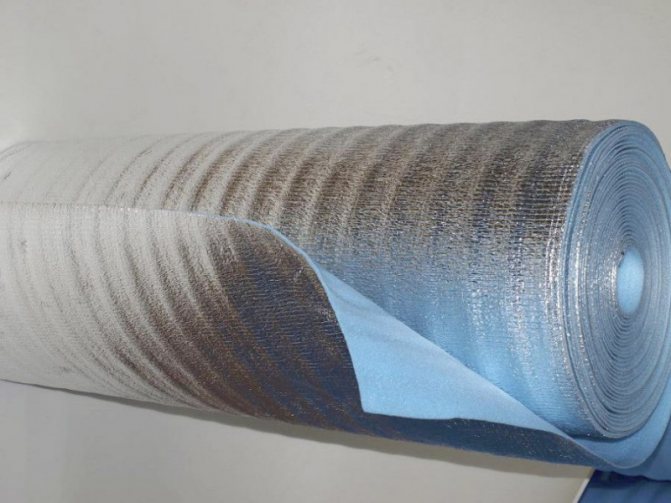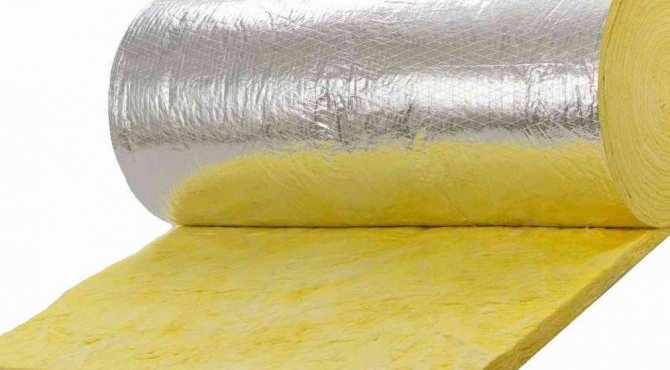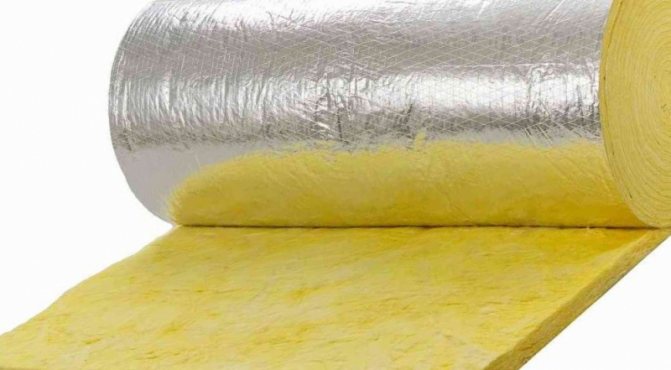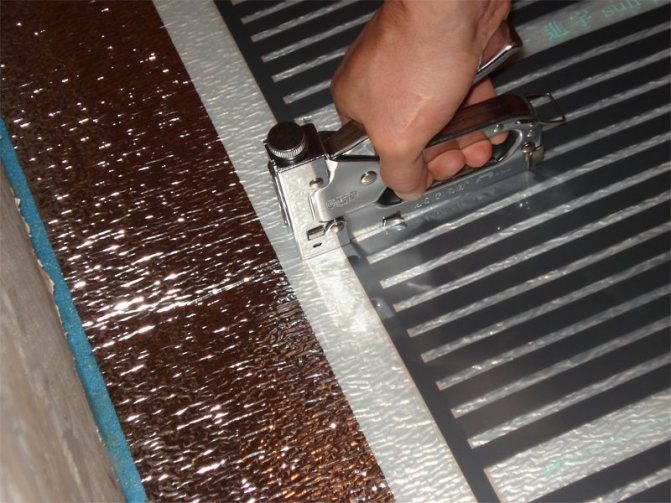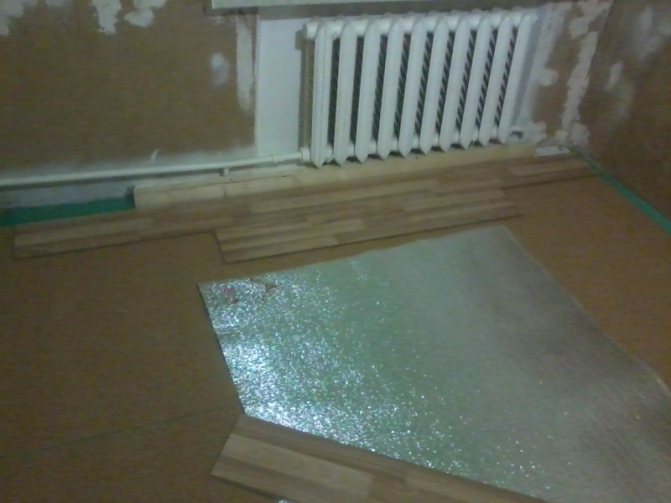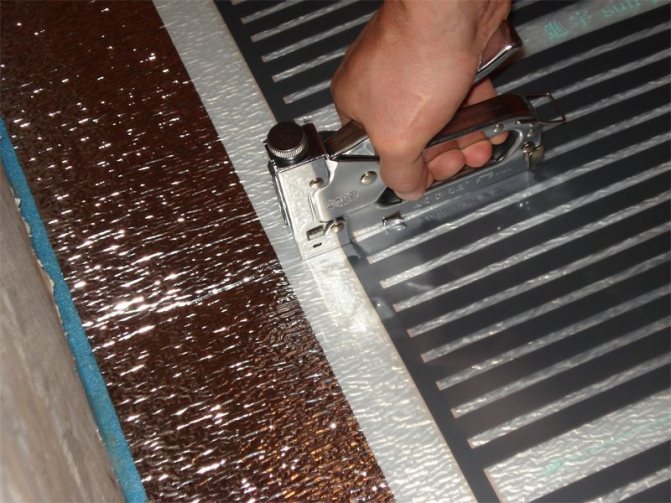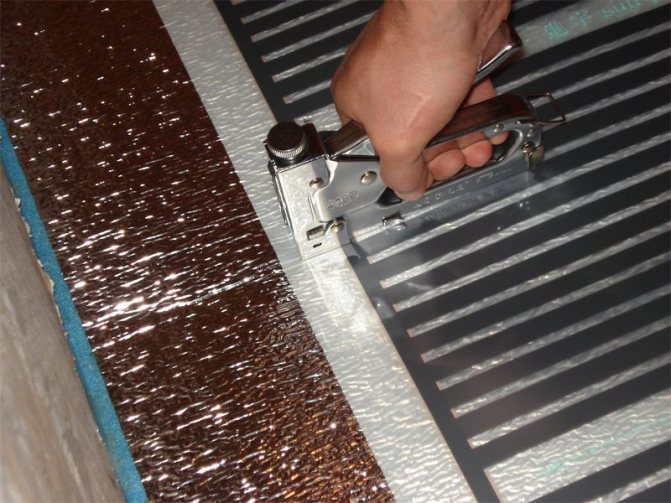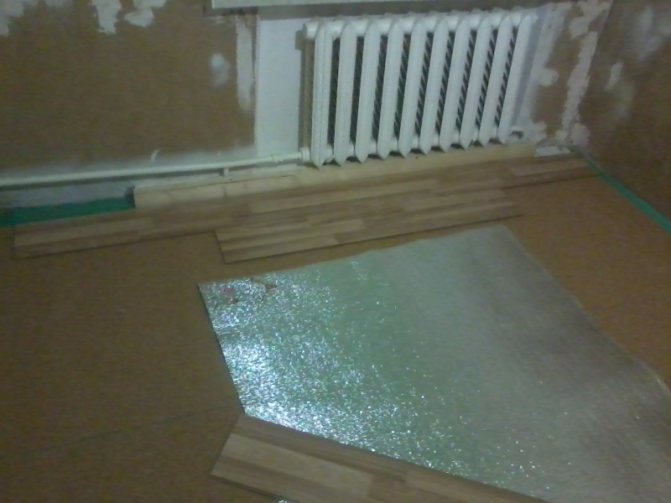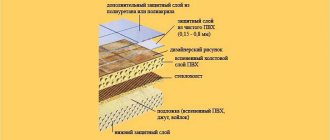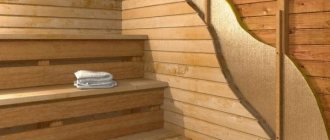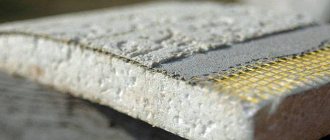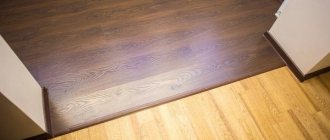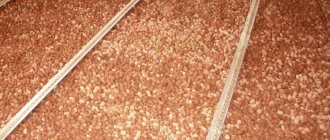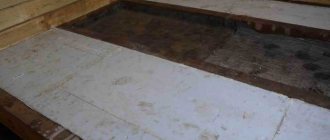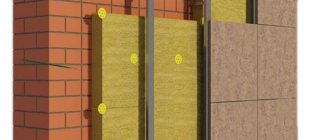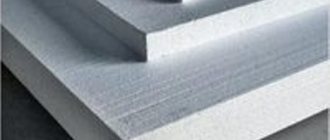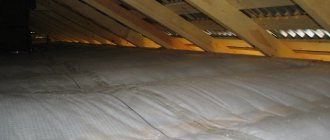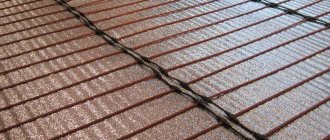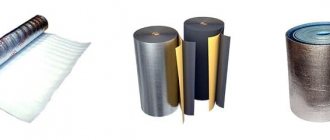Advantages of insulation with foil
Foil-type heaters have a lot of advantages that many other materials lack. It is for these positive properties that the foil thermal insulation is so loved by consumers:
- Effective reflection of thermal energy. Foil is an excellent reflector that repels about 90 percent of the heat, keeping the heat out and keeping the room cozy and warm. It is noteworthy that this property determines the fact that special suits for firefighters and rescue services are made on the basis of a foil-clad heat insulator.
- Waterproofing characteristics. Foil is a hydrophobic material that repels moisture.
- Ease of use. Insulation material with foil has a cellular structure. Thanks to this, it is easy to install and perfectly insulates surfaces from moisture.
- Isolation of surfaces from external influences. The foil type of insulation does not let dampness, wind flows through itself, does not dry out in summer and does not freeze in winter.
- Noise suppression. The use of foil-clad insulation can reduce the amount of external noise in the room.
- Environmental friendliness and harmlessness. Foil has no negative effect on the human body. In addition, the material does not harm the environment and does not emit any toxins.
- Long service life. Foil is very durable, as it is not afraid of corrosion, decay and rust.
- High degree of elasticity. Foil material can be easily shaped into one shape or another.
Specifications and issue price
It is impossible to name the general characteristics of all foil-type heaters - different materials have different properties. But you can consider the characteristics of the most popular and affordable heaters.
Foil and polyethylene foam insulator
In most cases, the material is sold in compact rolls. The thickness of the insulation varies from 2 millimeters to 1 centimeter. Foamed polyethylene can be coated on both sides and on one side. In addition, self-adhesive material is found on the market, when one of its surfaces is covered with an adhesive layer and a protective film.
The scope of use of polyethylene foil insulation for walls, as a rule, is not limited: they are used to insulate floors and walls, roofs, ventilation, refrigerators or pipelines. Also, quite often, this type of heat insulator is used for installing a warm floor, for insulating baths and as a topcoat for linoleum or laminate.
To prevent heat escaping through the wall structures, a layer of insulation based on polyethylene and foil is fixed behind the heating radiator so that there is about two centimeters of free space between the insulation and it.
Foil-clad polyethylene is often used in the manufacture of shoes - good shoe insoles are made of this material.
In building materials stores, there are often such names of materials as Ekofol, Izolon and Penofol. Price per roll is in direct proportion to the thickness of the material. For example, a roll of insulation with foil 2 millimeters thick will cost about 1,700 rubles. With a thickness of 1 centimeter, the cost will be about 3,500 rubles.
Mineral wool with foil
In this type of heat insulator, only one side is often trimmed with foil. It is sold in two different formats: rolls and slabs. The thickness of the insulating layer is from 4 to 10 centimeters. It is made on the basis of basalt wool or fiberglass.
The use of foil mineral wool is limited, since the material is harmful to human health, it causes lung disease and releases phenol into the environment. It is mainly used for external insulation of buildings and non-residential premises. Basalt wool is not subject to combustion, it is installed if resistance to high temperature indicators is required: on fireplaces, oven pipes, etc.
Properties such as moisture absorption, density and others depend on the brand and type of cotton wool, as well as the characteristics that were incorporated into the material by the manufacturer. The good waterproofing qualities of such a heater make it possible to use it in showers, saunas and baths.
The most popular brands Isover, Park, Ursa and Rockwool are considered. The cost of the material is approximately 1,300 rubles per 0.25 cubic meters.
Foil heat insulator made of expanded polystyrene
It is a thermoplastic with increased strength, which is obtained by melting polystyrene granules. It is produced only in the form of individual slabs. A similar material can be used in places that are subject to significant mechanical stress and moisture - strong polystyrene with foil is not subject to rotting and attack by mold or mildew. Therefore, it is often used when installing a warm water floor. The average cost is 90 rubles per stove.
The nuances of fastening and installation
The foil side of the insulation should be directed towards the interior of the room
There are rules for installing thermal insulation with foil.
- The parameters of foamed polyethylene allow you to leave the amount of living space unchanged. You can lay the material using a simple construction stapler.
- Lay the foil insulation on the floor so that the aluminum side of the material is located towards the inside of the room.
- Basalt wool is placed with a layer of foil upwards. It is necessary to work with this material in special protective clothing and a respirator, as it emits substances harmful to humans. For convenience, the basalt is sawn into lamellas (strips) of the required width.
- It is important to fix the EPS boards to the floor in the right direction. They are placed under the linoleum tightly to each other. The foil ensures the tightness of the connection.
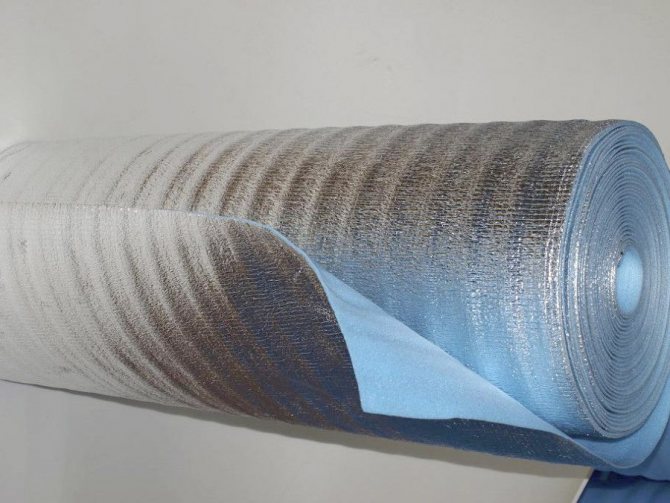
Installation of insulation is easy, it is easy to cut and fit. Work outside and inside is almost the same.
The main nuances:
- the surface on which the insulation is placed must be clean;
- the material is straightened so that it is even, without folds;
- the foil prevents heat from escaping, so it is laid with the outside side up;
- the insulator is glued end-to-end, the joints are glued with tape;
- if the insulation does not have a self-adhesive layer, use a special glue.
It is important that the adhesive used for fastening does not emit harmful substances and holds the material firmly.
Plates are mounted with dowels on vertical surfaces
Installation of insulation to the wall should be thoroughly thought out. An air gap is left between the material and the subsequent finish to avoid condensation.
- The membrane is fixed, an insulator is rolled over it.
- The material is fixed with slats. Their thickness should be greater than the main insulation.
- At the edges of the rails, the insulator is connected with staples.
- The paneling is done on top of the strips, their thickness provides the required air gap.
The joints are sealed with aluminum tape
Underfloor heating, regardless of whether the base is wooden or concrete, is done in the same way.
- Clean the floor of debris before applying insulation.
- Cover the base with a primer.
- After drying, roll out the insulation. The strips are laid with an overlap, fastened with construction tape. Under the linoleum, you can expand the underlay, which will make the floor much warmer.
- A topcoat is applied on top of the insulating material.
If it is planned to lay a warm floor, the insulation must be put with the reflective side up, then the reinforcing mesh, heating elements and the finishing cladding.
The peculiarity of installing foil-clad insulation is that the shiny side with a metal coating should always be directed towards the interior of the room. Incorrect setting will result in loss of reflective effect, i.e. decrease in thermal insulation.
Between the finishing of the wall and the layer of foil insulation, it is recommended to maintain an air gap of up to 1.5 cm for additional thermal protection, a thermos effect.
The home craftsman will need to install the insulation:
- nails with a large head;
- hammer and nail puller;
- construction tape;
- acrylic or rubber glue;
- construction stapler.
You can cope with the work alone, but installation together, with an assistant, will go faster.
Sealing gaps with aluminum tape
The main stages of laying insulation:
- Preparing the wall. Insulation of walls with old wallpaper from the inside requires preliminary cleaning, covering with an antiseptic.
- Fastening the insulation. It is allowed to stick roll sheets on the wall or to construct a lathing, in the cells of which the slabs are attached. The first mounting option is more common.
- Additional fixation of the insulation with a construction stapler or nails.
- Treatment of crevices with aluminum tape.
- Anchoring the battens to create an air gap before the final cladding.
We suggest that you familiarize yourself with What stones for a bath to choose for health
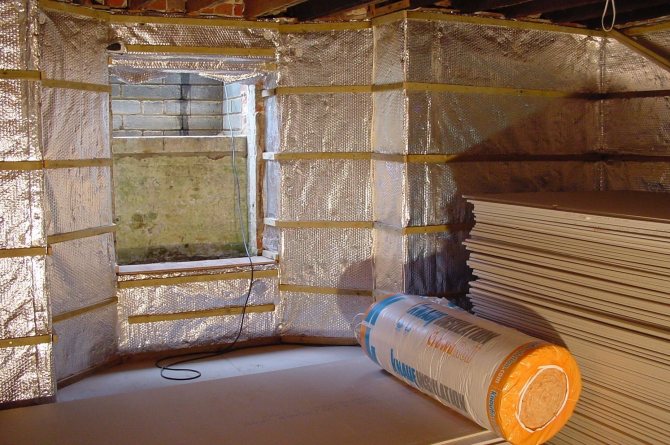

Basement thermal insulation with foil insulation from the inside
When installing insulation inside a room, at home, consider:
- laying mineral wool should be in dense rows without gaps between the plates;
- material foiled on both sides needs two air pockets - from the outer wall, from the finishing;
- sheets of rolled insulation are never overlapped on each other;
- the fastening of self-adhesive mineral wool with a foil layer must be reinforced with nails around the perimeter to reduce the risk of delamination.
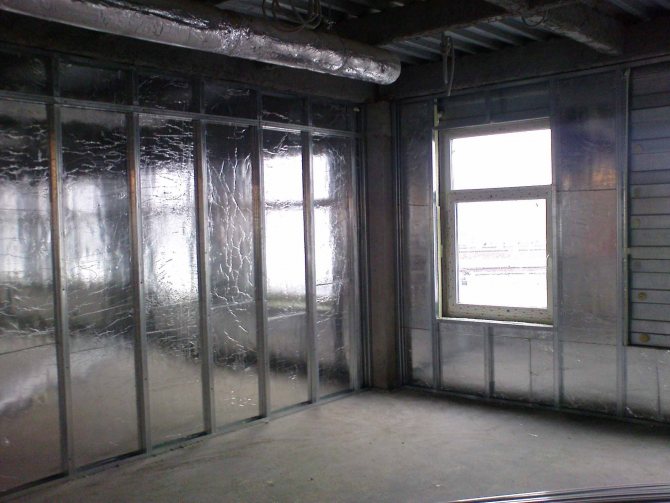

Insulation of the garage from the inside
If the room is completely lined with insulation, then work should start from the ceiling, then go to the walls, lay the floor insulation - last.
Insulation of the walls from the inside is preferable, as it allows you to better keep warm. If for some reason this cannot be done, then heat-insulating materials are mounted outside. Experts recommend using foil-clad mineral wool.
The master will need the following materials and tools to carry out the work:
- medium thickness mineral wool with a foil layer;
- glue;
- construction gun;
- brush;
- windproof film;
- dowels.
Insulation of the outer wall is the formation of a "puff cake" in a certain way with a filling in the form of a heat insulator - foil-clad mineral wool. The work is carried out in stages:
- Creation of a metal lathing for the arrangement of plates of heat-insulating material. The structure is attached to the concrete or wooden wall of the building using dowels. The choice of a metal frame is more reliable than a wooden one, since the cladding will be resistant to deformation when exposed to various temperatures and humidity.
- Fastening the insulation on the crate with gluing on the wall. On the reverse side of the foil-clad mineral wool slabs, it is required to apply a point adhesive mass, press it against the wall. Dowels can be additional fasteners.
- Smoothing the surface with a sanding brush.
- Securing windproof film, waterproofing. Fixation is carried out with a construction stapler, small nails with large heads.
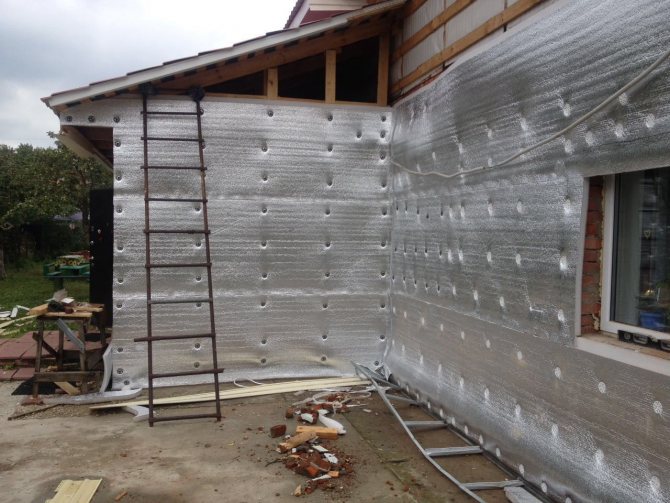

Insulation of a brick house outside
It should be borne in mind that the construction of a metal sheathing from a galvanized profile should be taking into account the width of the panels, heat insulator plates in order to reduce the number of joints.
The finish is usually mounted on an additional subsystem while maintaining the ventilation gap.
Sheathing of external walls of wooden structures can be made with foil foam. The material is lighter, the cost of insulation is lower. It is recommended to choose a perforated type of foam foam to enhance the protection against wetting of the walls.
Before direct installation of the insulation, the walls must be treated with an antiseptic, paying special attention to the corners of the house. It is recommended to glue the joints of foam sheets with metal tape. The lathing can be wooden. The work is carried out in the same order as when installing mineral wool.
It is important to take into account that the insulation of the outer walls of the house is carried out exclusively in dry weather at a positive air temperature.
The use of foil-clad insulation enhances the effect of maintaining a comfortable indoor environment. Experts recommend taking this factor into account when deciding on the choice of thermal insulation material.
Consider which side to correctly lay the insulation with foil on the floor.
Heat-saving properties depend on how well the insulation is laid.
The foil reflects infrared radiation, therefore, the metallized layer must be laid so that it looks into the room.
Place the packing material with the foil facing down.
Most often, the roll material is fixed to a concrete base on a special glue made on the basis of rubber.
Installation sequence:
- Preparing the surface. We align the slab so that there is no large difference in height. We seal all cracks and cracks with cement mortar.
- We spread the material on the floor with a foil layer upwards, cut it off to the desired length. We move the strip aside, apply glue to the place of its laying. We stand for several minutes according to the instructions for the glue. We lay and press the material well. We put the strips close to each other.
- We fix the joints with foil tape, which is sold in hardware stores.
Features of the use of foil insulation
The use of materials with foil for insulation depends on a couple of indicators: the properties of a particular heat insulator and the place where it will be used. In general, with the help of such thermal insulation, floor structures are insulated, the heat transfer of heating radiators is increased, air ducts and pipelines are trimmed. An excellent result gives and thermal insulation of entrance doors to verandas, loggias, porches and balconies.
When installing foil-type insulation, you need to acquireall the necessary tools for work:
- Construction stapler.
- Small carnations with a large cap.
- Claw and hammer.
- Foil-coated construction tape.
- Insulation with foil directly.
The most common mistake of many builders is the incorrect installation of the material with the foil surface outward. Due to the fact that the foil is a reflector, it is designed to return heat to the room. And by placing the insulating material on the wrong side, such an effect cannot be achieved.
Stacking foil heat insulator, it is recommended to enclose it in a crate made of wood.
Boards, rolls or sheets of material must not be overlapped. They must be installed strictly on the same plane, secured with nails or construction staples.
A material with an adhesive surface can be left unsecured with additional fasteners, but it is better to use small studs to increase the service life. In the absence of an adhesive coating, a rubber or acrylic adhesive can be used to fix the material to the surface.
After installation and fixing all layers heat insulator, the joints between them must be treated with foil tape. This completes the installation.
When installing the heat insulator on vertical surfaces on which there is mold, wallpaper or dirt, they must first be cleaned, otherwise the fixation will turn out to be very unreliable, and the material will simply fall off over time. In addition, it is recommended to treat the surface with antiseptic agents.
Easy-to-use and very high-quality foil insulation will save money and keep your home cozy and warm.
Foil material occupies a special place in a wide range of floor insulation materials. Thanks to the reflective surface, the effectiveness of the thermal insulation layer increases significantly, providing a comfortable environment in the home. Lightweight, durable, with good soundproofing properties, foil insulation for the floor is becoming more and more popular in private housing construction, especially since its installation is not particularly difficult.
Foil insulation for the floor
Composition and properties of foil material
This insulation consists of two layers - a base and a reflective coating. As a basis, classic heat insulators are used - foamed polyethylene, expanded polystyrene, mineral wool and other materials. The reflective coating is a metallized polypropylene film or a thin layer of aluminum foil. The thickness of the insulation directly depends on the type of base.
Foil insulation for the floor consists of two layers
Varieties of heaters
The insulation on polyethylene foam has a thickness of 2 to 10 mm and is produced in rolls. Usually it is used when installing a "warm floor", with further filling of the screed, and as an insulating substrate for some types of floor coverings. Self-adhesive material is especially popular, the installation of which takes a minimum of time. The insulation has many varieties, of which the most popular are Izolon, Ekofol, Folgoizol, Penofol and Isoflex.
Insulation based on fiberglass and mineral wool has a thickness of 50 to 100 mm, it is commercially available in the form of rolls and slabs. It is used for warming interfloor ceilings, thermal insulation of baths and saunas. Basalt insulation with a foil coating has increased heat resistance, but has one drawback: it contains phenol, which is unsafe for human health. The most popular brands of insulation: Knauf, Rockwool, Park, Izover.
Foil insulation Rockwool
A heat insulator based on expanded polystyrene is produced in the form of rigid plates covered with foil. It is used when laying a warm water floor, as well as for thermal insulation of surfaces exposed to dampness and heavy loads. For the convenience of laying heating pipes, special red markings are applied to the foil coating.
Insulation properties
Foil heat insulators have the following properties:
- high reflectivity;
- resistance to temperature extremes;
- moisture resistance;
- excellent steam, hydro, sound and heat insulation performance;
- resistance to mechanical stress;
- durability;
- light weight;
- ease of installation.
Floors with such insulation will never become damp, do not require treatment with protective agents, and will last much longer.Most foil-clad heat insulators do not contain carcinogenic components, therefore they can be used in any room, in addition, they reflect radiation, which is now important.
Aluminum foil reflects heat well
The type of coverage is of great importance. Aluminum foil perfectly reflects heat, but it breaks down under the influence of alkalis in concrete, and metallized film is not susceptible to such effects. That is why insulation with an aluminum layer is not used under a concrete or cement screed. The thickness of the reflective layer is no less important: some manufacturers make a simple spraying over the heat-insulating base, which significantly reduces the effectiveness of the insulation. The thinner the layer, the easier it is for thermal radiation to pass through it.
Aluminum foil - features of the use of thermal insulation
Thermal insulation aluminum foil is a modern building material designed to retain heat by screening heat energy back into the room. Due to its porous structure, this material has a low thermal conductivity, which allows it to be used not only as a screen, but also as a heater.
What is aluminum foil for thermal insulation
This material usually consists of two layers:
- The bases are made of expanded polyethylene, extruded polystyrene foam or mineral wool, which serves as an additional insulation.
- An additional layer of a special aluminum alloy that fully reflects the visible spectrum of thermal energy and retains up to 90% of infrared radiation.
There are also varieties of single foil insulation - it is used for chimneys, baths, saunas.
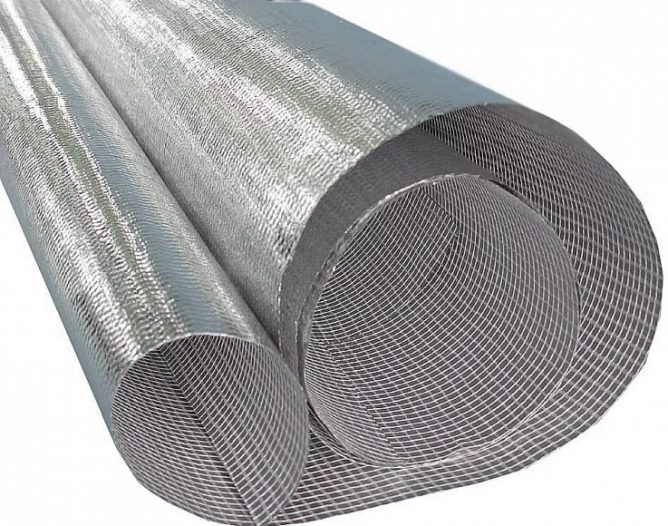

The principle of operation of aluminum thermal insulation
The principle of keeping warm with this type of insulation is very simple. Due to the presence of a large number of air bubbles in the structure of the main layer of foamed polyethylene foam, the material, according to the "thermos" principle, retains heat for a very long time. And thanks to a special aluminum coating, all heat from energy radiation sources (heating radiators, convectors, air conditioners, etc.) does not pass through the thermal insulation, but is reflected and returned back to the room.
Where Aluminum Foil Is Used For Thermal Insulation
This material, due to its excellent technical characteristics, is used in the production of construction and installation works, namely:
- For wall insulation before installing mineral wool insulation, extruded polystyrene foam or liquid insulation.
- When installing the "Warm floor" system to reflect infrared rays and thermal energy into the interior of the room.
- When installing a vapor barrier for the roof and rafter system.
- When insulating ceilings made of plasterboard, OSB or suspended ceilings in multi-storey apartments, private houses or cottages.
- As a substrate for laminate or parquet.
- For thermal insulation of pipes for hot water supply and heating.
- When building baths, saunas or boiler rooms (self-adhesive thermal insulation).
- When installing a centralized ventilation and air conditioning system in industrial and semi-industrial premises.
This list can be continued indefinitely, but let's try to answer the question: "Why did aluminum thermal insulation deserve such popularity?"
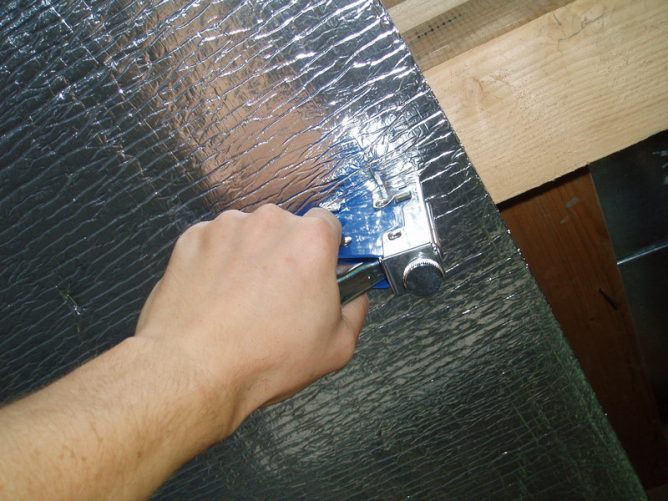

The main advantages of aluminum insulation
- Environmental friendliness of the material. Foil insulation is made of food grade aluminum foil that meets all sanitary requirements.
- Energy efficiency. With proper installation, heating costs can be reduced by 40-60%.
- Big choice. Depending on the needs, foil-clad insulation is made with a thickness of 2 to 20 mm.
- Compliance with fire regulations.Thanks to the use of special components that are added to the main layer of insulation, the material is flame retardant.
- Effective work in extreme conditions. This material is able to withstand temperatures up to 1200C, making it ideal for arranging thermal insulation in baths and saunas.
- High plasticity and elasticity (self-adhesive foil). The aluminum foam backing can stretch and shrink without losing its properties, making it suitable for protecting laminate, parquet or linoleum flooring.
- Anti-corrosion property. This material is absolutely non-corrosive, so it can be used in rooms with high humidity.
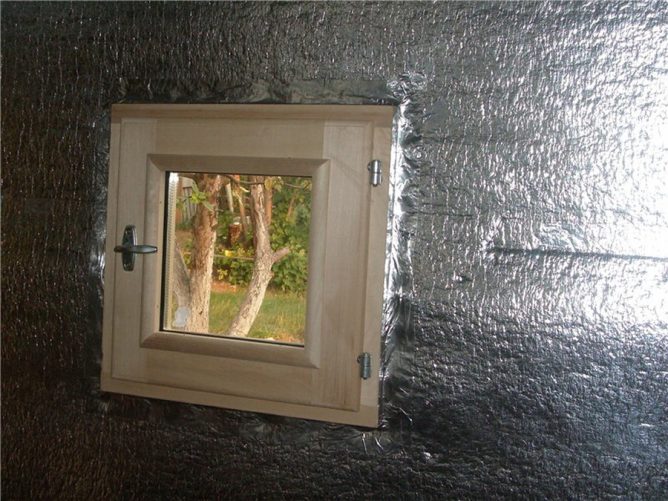

conclusions
Aluminum foil for thermal insulation is a reliable and effective insulation for any room, which is characterized by:
- excellent technical characteristics;
- increased fire safety;
- long and reliable service life.
Roll material stacking technology
Roll stacking technology
Thermal insulation of a wooden floor
To work you will need:
- insulation;
- scissors;
- metallized scotch tape;
- roulette;
- grinder;
- antiseptic primer;
- putty.
Self-adhesive insulation is best for wood, but if you purchased a regular one, you can attach it to the surface using a construction stapler or double-sided tape.
We insulate the wooden floor
Step 1. Carefully prepare the base: remove the baseboards, remove debris and dust, treat the surface with a grinder or scraping. If there are gaps, you need to seal them up with putty.
Laying panel material
Reflective insulation in slabs
Reflective insulation in slabs is installed mainly under warm floors, although it can also be used as a conventional insulation. A floating screed is made with foil mats and placed between the logs.
Floating screed
Step 1. The concrete surface of the floor slabs is leveled with putty and sanding. Dust cleaning.
Step 2. Using a level gauge, mark the screed fill line on the walls.
Step 3. A damper tape is attached to the walls along the perimeter of the room and the base is primed.
Damper tapes Kermi
Step 4. Plates are taken with a metallized coating, since aluminum is corroded by cement. Glue is dotted on the base of the mats, after which the insulation is placed on the floor with a reflective layer up. When laying the insulation, the joints are carefully adjusted so that gaps do not form.
Step 5. The joints are glued with tape, and then the heat-insulating layer is poured with a screed solution. Level the mixture with a wide spatula or a rule and leave to dry. After that, you can lay the finishing coating.
Video - Laying foil mats
Warming on lags
Step 1. Remove the floor covering, clean the base from debris, check the integrity of the logs, repair damaged elements if necessary.
Step 2. A waterproofing material is laid on top of the logs and fixed with a stapler from the inside of the beams, well straightening the film on the floor. The edges of the canvases are overlapped by 10-15 cm.
Step 3. The space between the lags is filled with foil plates, laying them in one or two layers. The slabs of the second layer must necessarily overlap the seams of the lower layer. A gap of 1.5-2 cm is left between the reflective coating and the upper edge of the lag.If the gap cannot be left, a crate of 20x40 mm laths is stuffed on top of the lags.
Foil basalt mats
Step 4. Further steps depend on the type of flooring. If it is linoleum or laminate, the rough base is covered with sheet material - plywood, chipboard, OSB. If the floor is made of boards, they are stuffed directly onto the logs.
Table of the main properties of foil heat insulators
| Name | Properties | Thermal conductivity | Where is applied |
| Izolon | Elastic material, lightweight, waterproof and durable | 0.040 W / mK | As a substrate for laminate and linoleum, mounted under warm floors |
| Penofol | Flexible, thin material, environmentally friendly, waterproof | 0.037-0.049 W / mK | Can be used as a vapor barrier for conventional thermal insulation materials |
| Isover | Non-combustible, dense heat-insulating material | 0.041 W / mK | For insulation of concrete and wood surfaces |
| Rockwool | Durable, non-flammable material, resistant to deformation | 0.39 W / mK | Insulation of floors on logs, heat and sound insulation of walls and ceilings |
| Foil polystyrene foam | Resistant to temperature changes, durable | 0.037-0.041 W / mK | For insulation of a warm water floor, insulation of a floating screed |
Video - Foil insulation for the floor
Useful about blocks, mixes and concrete admixtures
Application
Penefol (closed cell polyethylene foam) is versatile in use. They insulate walls, floors in living quarters.
Foil insulation for pipes and roofs - foil insulation. It is also used in the construction of industrial facilities.
Rolls of mineral wool with an aluminum layer are used in the same way as ordinary insulation mats: to insulate walls, floors and other structures. The difference between foil-clad mineral wool and the usual one is built-in waterproofing, aluminum does not allow moisture to enter the fibers, preventing the material from getting wet.
An ideal foil-clad insulation for a bath based on basalt: it has a low heat transfer coefficient, is not afraid of humidity and large temperature changes. As you know, stone wool is a hard material. To roll it into a roll, the basalt is sawn into lamellas, and they are laid on an aluminum base. This insulation is used to isolate various social and industrial facilities.
Foil polystyrene foam is used for floor insulation.
All materials with an interlayer of aluminum foil have a higher technical performance than their traditional form. The cost of foil-clad insulation is an order of magnitude higher than the cost of conventional material, this is the main disadvantage of the "advanced" sample.
The first and most important question is which side to put the foil insulation on?
The first rule of installation: the reflective side should be directed towards the room. This will ensure natural heat reflection.
We insulate the walls
The structure of insulation and decoration must be thought out: there must be an air gap between the insulation and the subsequent decoration in the case of walls. When using a mineral wool base, it is necessary to isolate the material from the penetration of water; for this, a membrane is attached to the base that allows steam to pass out.
How to fix the foil insulation to the wall: roll the insulator over the fixed membrane and fix it with guide rails, the thickness of which should exceed the thickness of the main insulation. The layers are connected with staples along the edges of the rails. The subsequent finishing from panels or lining is carried out along guides, which provide an air gap with their thickness.
Some craftsmen recommend protecting the foil with vapor-proof films to prevent moisture from entering the body of the mineral wool layer through possible holes in the metal.
We insulate the floor
For wood and concrete floors, the procedure remains the same:
- The base is cleaned of old coatings, the debris is thoroughly swept out.
- Primer the subfloor with a concrete or wood primer.
- After the primer has dried, measure the required amount of rolled insulation and roll it out. Optimal use of adhesive-backed material. The strips are laid with an overlap of 10 cm, the joints are glued with aluminum tape.
- The top coat is laid on top.
If an electric or water “warm” floor is provided in the room, rolls are rolled with the reflective side up, a reinforcing mesh is laid on top, then heating elements and a cement screed is made, followed by cladding.
How To Lay Foil Insulation On The Floor
- Anara Posted on 01.02.2019FollowNo Comments
There are a huge number of different heat insulators. Foil insulating material reflects up to 97% of infrared radiation towards its arrival.
It is made based on expanded polystyrene, foamed cellophane, mineral and basalt wool. Its efficiency depends on the correct installation.
Next, let's see which side to put the heat insulator with foil on the floor, the types and properties of materials, the rules for laying them.
This is a combined material that consists of a layer of duralumin foil or a metallized film, combined with a heat-insulating material. You will like the reflective layer more one-sided as it is also called two-sided. Differs in easy and quick installation due to its own elasticity. Narrower than other thermal insulation materials.
The aluminum coating has the greatest characteristics in terms of heat reflection, alas, it is destroyed by the action of alkalis in concrete. The metallized coating is resistant to alkaline attack. Spraying doesn't actually do a function of its own.
In addition to retaining heat, it is used for waterproofing, because it does not allow water to pass through itself. The thinner the foil layer, the better it allows heat to pass through itself.
There is a huge variety of foil-clad heat insulators.
They differ in the materials used at the production stage.
The properties of heat insulators with a foil layer are described in the table:
When choosing, it is necessary to take into account the requirements for the premises and its functional purpose. The top layer is expected to be covered with duralumin foil, and not by spraying.
Types of heaters
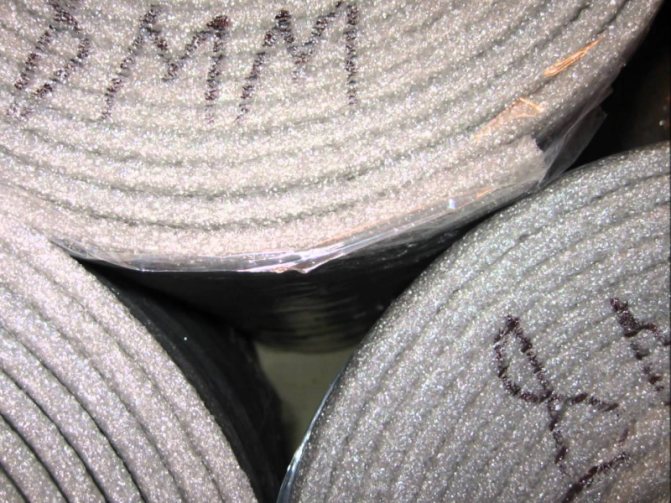

There is a wide variety of foil insulation.
They differ in the materials used in the manufacture.
The characteristics of heaters with a layer of foil are described in the table:
When choosing, you need to take into account the requirements for the room and its functional purpose. The top layer should be covered with aluminum foil, not sprayed on.
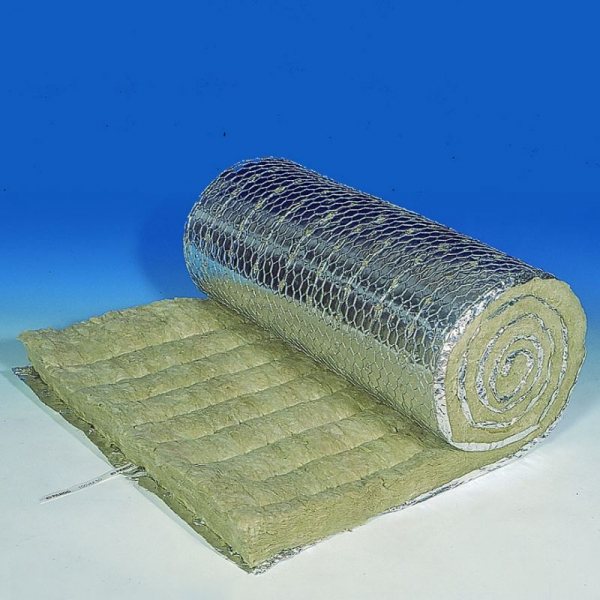

The materials used in production are most often environmentally friendly, safe for health and the environment.
- light weight;
- durability;
- resistance to loads;
- protection against moisture penetration;
- high rates of heat saving and sound insulation;
- resistance to temperature changes;
- ease of styling;
- high reflective properties.
Such insulation can be used in any room. In addition to the qualities described, it is capable of reflecting radiation radiation.
How do I lay the underlayment on the floor?
When the material is laid, of course the selected floor covering must be installed.
The base for underfloor heating must be level without height differences and flaws. What remains for our client to do is to remove errors.
Stages of laying thermal insulation with a layer of foil:
- We lay out the foil material in strips end-to-end, glue the joints with special tape.
- From above we mount a system of electronic or water heated floors.
- We lay hydro and vapor barrier material. It will prevent the concrete from leaking onto the floor heating elements.
- We fill the screed with a width of 30-50 mm, starting from the type of heating parts and the multifunctional purpose of the room.
Warm floors have an option to turn on only after the screed is completely dry. It will take about a month.
It is characterized by the fact that the slab does not bond aggressively with the concrete screed, they have thermal insulation.
- We prepare the base, we eliminate our client's shortcomings.
- We plaster the lower part of the walls.
- We glue a damper tape around the perimeter of the walls, its height must be the thickness of the floor: from the slab to the floor covering.
- We prime the base in two layers. Apply the next layer after the previous one has dried.
- We lay the heat-insulating foil plates upward with foil. We use a metallized coating that is resistant to the effects of cement mortar. Plates are laid strictly in a horizontal plane, tightly together. Uneven laying of insulation boards promotes the formation of cracks in the concrete solution.
- We glue the joints of the plates with adhesive tape.
- Fill the screed with concrete.
Lightweight and durable heat insulator with a layer of foil is used by our client and remains more popular among consumers and professional builders due to its high heat retention characteristics and ease of installation. For more on isolation, see the video here:

